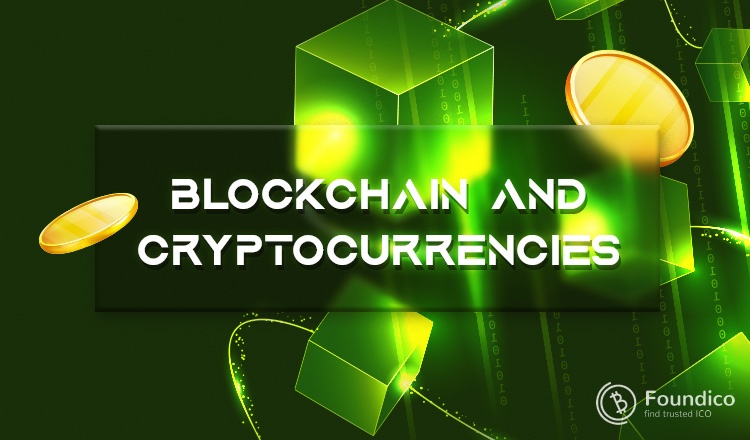Cryptocurrency is a digital asset secured by strong asymmetric cryptography. Historically, the first blockchain implementations focused on the creation and management of cryptocurrencies. The use transparent peer-to-peer technology with automatic validation of transfer records, such as blockchain, for cryptocurrency accounting is natural, and to date most public blockchains use some form of cryptocurrency.
This is realized e.g. payments for use and is somehow linked to the consensus algorithm. It should be added, however, that it is persistent in practice, the combination of blockchain and cryptocurrency is not mandatory, nor desirable in many applications. Blockchain is associated in the media and in the eyes of the public mainly with cryptocurrencies. However, cryptocurrencies and blockchain can operate without each other, but their connection is in some cases mutually advantageous. Cryptocurrencies and blockchain have four main intersections, common areas of deployment:
· Cryptocurrency as a substitute for FIAT currency in payments and investments,
· Cryptocurrency as a remuneration of the network operator (node),
· Cryptocurrency as a fee for using the network (usually just for enrolment),
· Cryptocurrency as a representation of objects, rights, etc. from the real world in the form of tokens (Tokenization of assets).
Cryptocurrency as a substitute for FIAT currency in payments and investments
This use is probably best known, with many people and companies investing in cryptocurrencies for profit, possibly diversification of the investment portfolio. Use in the payment system, which should have been cheaper, faster and anonymous, has not yet fully met expectations: fees are sometimes higher than with the classic payment system, the speed (e.g. for Bitcoin) is significantly lower than when authorizing a card payment and anonymity is also debatable. The problem is also usually very high volatility.
Cryptocurrency as a remuneration of the network operator (node)
The node operator had to invest in the construction of the node and cover the costs associated with its operation. In public blockchains, he is rewarded with a cryptocurrency based on his success block extraction / validation according to the consensus algorithm used in the given network. The amount of the reward we can manage network development, motivate the arrival of new node operators or reduce its charges for a sufficient number of nodes. In private or consortium blockchains such as reward may not exist, operators may have different incentives to build and operate network nodes (agreement, regulations, obligation, other benefits).
Cryptocurrency as a fee for using the network (usually just for enrollment)
Blockchain network users can pay for each use of the network and these fees can fund the network operation and development. The fee is usually collected only for registration, reading is free. The fee usually depends on the length of the transaction in bytes, the longer one that loads the network, the more you pay. This model is common in public blockchains and prevents network overuse or abuse. The fee does not have to be fixed- its variable height can be used to respond to sudden changes in network load, but in this case it is not possible to predict the amount of the fee at a given time and the amount of the fee may be higher.
Cryptocurrency as a representation of objects, rights, etc. from the real world in the form of tokens (Tokenization of assets)
Tokenization of assets is one of the main possible uses of blockchain apart of cryptocurrencies. It uses the unique feature of blockchain to reliably manage, record and prevent the misuse (multiple use) of cryptocurrency tokens. Instead of the term cryptocurrency, it is more appropriate to use the term token. In this case, we represent real-world objects in the virtual token world and we control and monitor its use using a blockchain.
This can be, for example, shared ownership of transport objects (e.g. car, yacht, bicycle), real estate (e.g. apartment, office space) or even computing power or storage capacity in the data center. The token then represents the right to a means of transport or an apartment at a given time or storage capacity in a data center. Blockchain is used to handle these tokens between multiple users, prevents multiple uses (e.g. apartment or yacht at one time) and records their use by users.
However, blockchain can also exist without cryptocurrencies, in case of crypto-token can be used only for two, one or none purposes listed above. Crypto-tokens of a given blockchain do not have to be publicly traded at a floating rate. For example, when paying a citizen for state services (entry in register X, application for authorization Y) a crypto- token can be created, which a citizen gets for free in a certain amount and can buy more for a fee.

 Best Wallet - Best Wallet Token, revolutionizing the Web3 experience. $BEST token reduces transaction fees, grants exlusive early access to the hottest presales and gamifies wallet engagement.
Best Wallet - Best Wallet Token, revolutionizing the Web3 experience. $BEST token reduces transaction fees, grants exlusive early access to the hottest presales and gamifies wallet engagement.